Livelihood Projects of partner communities of the Integrated Rural Development Foundation
1. Rags for Profits – A community livelihood project of the women of Bgy. San Vicente
San Vicente, Bulan, Sorsogon

One of the key issues faced by rural women is the lack of economic opportunities and employment. Oftentimes, they do not have access to capital nor the skills that could be their ticket to gainful employment. So often when IRDF conducts dialogue with the local women, they would emphasize the need for livelihood activities.
Thus, when the women of Bgy. Vicente submitted a proposed project on rag-making, IRDF helped them design a business plan to prepare them launch their income generating project. Based on their business plan, IRDF gave out a loan of P10,000 as operating capital. Manay Estring, the leader of GABAY, the local women organization partner of IRDF provided the sewing machine.
With this, 12 local women members of GABAY in San Vicente, embarked on implementing and managing the rag-making project.
The loan of P10,000 was used to buy 100 kg of scrap cloth, threads and other sewing materials from Manila.
The following table shows the operations and profit earned by the women from this project for two cycles spanning 1.5 months.
Cost and Return Analysis
Rag making (two cycles)
I. GROSS INCOME
Sold 500 doormats/cycle ( at 5 doormats per kg of scrap cloth)
Price of doormat: P100/3 doormats at 500 doormats/cycle
Total of 1000 doormats for 2 cycles P 33,200.00
II. EXPENSE
- Materials
P 1,325.00/ 100 Kg of scrap cloth x 200 kg for 2 cycles 2,650.00
P 280 thread/ 100 kg of scrap cloth 560.00
Labor (P35/3 doormats at 1000 doormats) 11,666.00
Sewing machine maintenance 1,000.00
————–
Total material cost 15,876.00
TOTAL EXPENSES 16,476.00
III. NET INCOME P 16,724.00
The net income is translated into an additional income of P1,356.00 or US31.50 per member of the women organization GABAY for one and a half month. Aside from this, the organization is able to provide employment to local women.
The women bought 200 kg of scrap cloth per month. They made 5 pieces of rug for every kilo of cloth. They usually finish 24 pieces of rugs in one day. The added income for each household brought more food into their tables, bought daily school supplies for children and empowered the 12 women members of GABAY.
Indeed, their product is not only a rag. While some are plain and others are colorful, these rags all represent the efforts of women in Bgy. Vicente to make their lives better and productive and thus contributing to community development.
Supporting Organic Vegetable Farming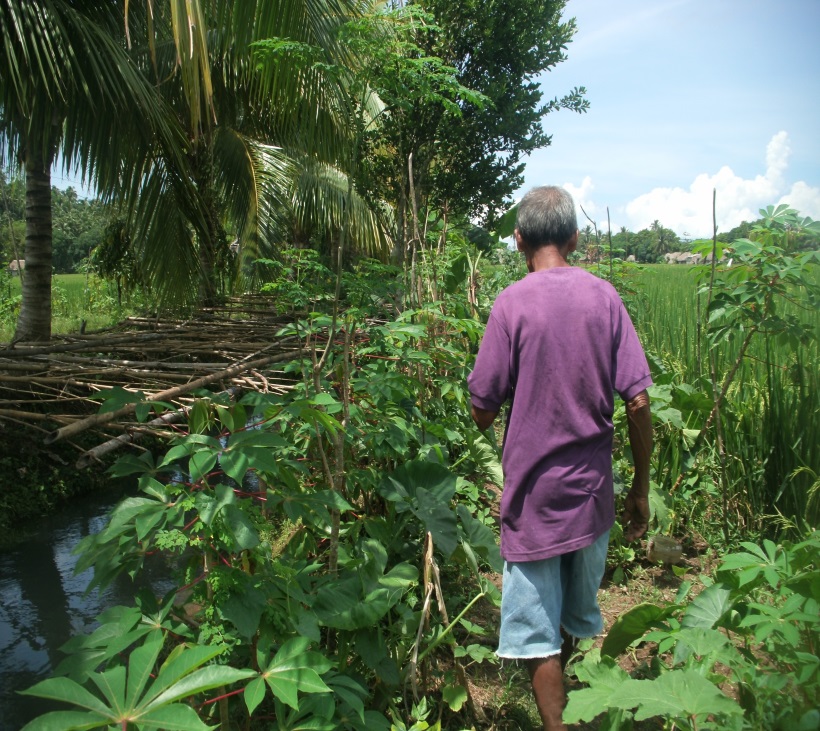
Polot, Bulan, Sorsogon
Modesto Gito, Bgy. San Francisco, Bulan, Sorsogon
Modesto Gito is a farmer from Bgy. San Francisco, Bulan, Sorsogon. He tills one hectare of riceland and plants a variety of vegetables which he plants along paddies and intercrop with coconut trees. He’s the Chairman of the barangay chapter of BIGKIS, a municipal farmer federation being assisted by the Integrated Development Foundation. Modesto received farm inputs like seeds and organic fertilizer and a sprayer from IRDF. The sprayer is dedicated for the biospray that he makes and which is used to control the pests in his vegetable farm. He plants pechay, squash, radish, bitter gourd, and pole sitao.
Since he attended the Organic Agriculture training of IRDF in February 2013, he has been keen on using organic composts for fertilizer and biospray. He concocts his own fertilizer using carbonized rice hull, cow dungs, and other organic wastes from his farm.
His vegetable farm now provides an additional source of income for his family. After deducting his expenses for seeds and for additional labor, he earns a net income of P6,535.00 per month from the vegetables that he sells to the market. Sometimes, he sells to employees of the municipal government and to IRDF’s network of NGOs in Bulan.
“IRDF has given me a chance to attend a seminar, from which I learned a lot about organic farming, natural pest management and community seedbanking. I want to share with my fellow farmers in Bulan, the new knowledge I gained,” enthused Modesto when asked what did he learn from IRDF.


Organic fertilizer production Vegetable plot
IRDF TECHNO-DEMO FARM
Irosin, Sorsogon
IRDF’s techno-demo farm in Irosin, Sorsogon was established to serve as showcase and demonstration of organic farming technologies and systems to support the training, adoption and conversion of small farmers into organic agriculture. The over-all goal of the farm is to increase farmers’ income and produce safe and nutritious food. Using organic materials lessens the use of expensive chemical inputs which raises production costs. Organic farming restores the soil that has become too acidic as a result of massive use of chemical fertilizers. Moreover, it presents an alternative system that contributes to climate change adaptation as well as minimizes emission of greenhouse gases. Some of the sustainable farming practices introduced include the use of different organic fertilizers, bio-prays, integrated pest management practices and soil and water conservation.
Components and features of the techno-demo farm include the nursery for seedling production, organic pig raising, goat raising, fishpond, free-range chicken raising, grazing area, organic vegetable production area and training center.
Among the organic fertilizers produced in the farm are BOKASHIi and vermicasts. Bio-sprays or organic pesticides used are the indigenous microorganism (IMO), fermented plant juice (FPJ) , kuhol amino acid (KAA), fish amino acid, oriental herbal nutrient (OHN).
The vermicasts are harvested and used to fertilize vegetables. Organic wastes from the pigpen, goat and chicken houses are also used for organic fertilizers when properly processed.
In the nursery, asexual propagation is demonstrated. Asexually propagated seedlings are sold to farmers at minimal cost.
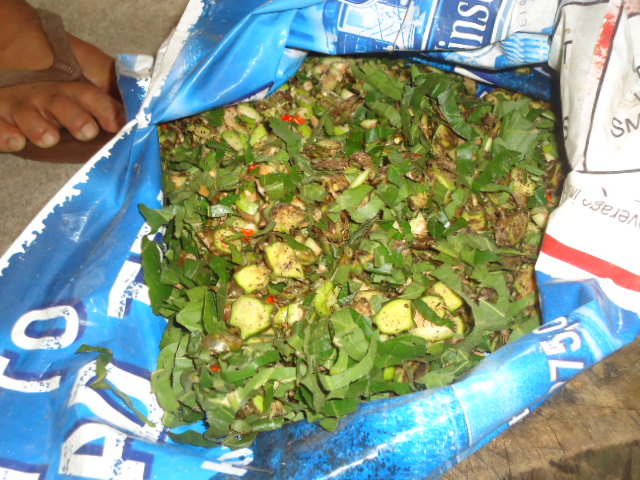
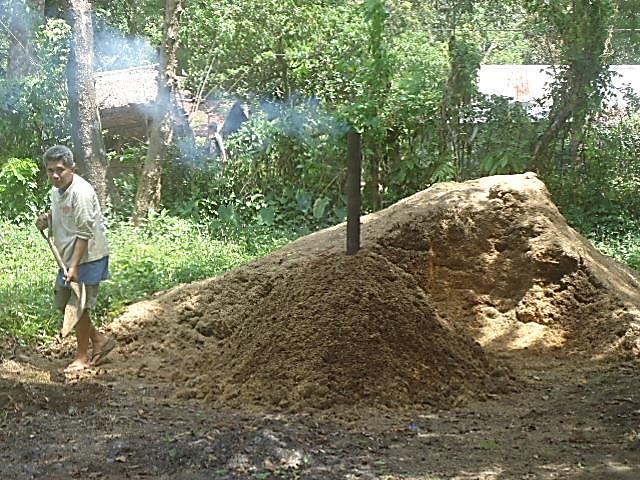
Materials for Bio-Spray Carbonizing Rice Hull for Bokashi
Soil and water management practices include mulching, planting of leguminous species as soil erosion control and to provide feeds for animals.
Vegetables, animals, fish and seedlings produced in the farm are sold in the market to cover the cost of operation.
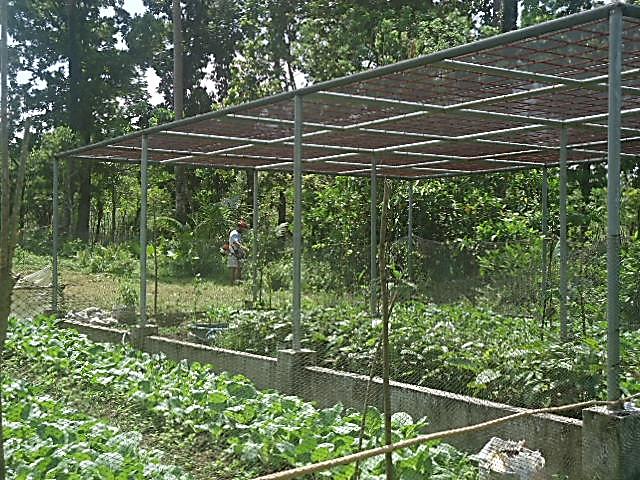
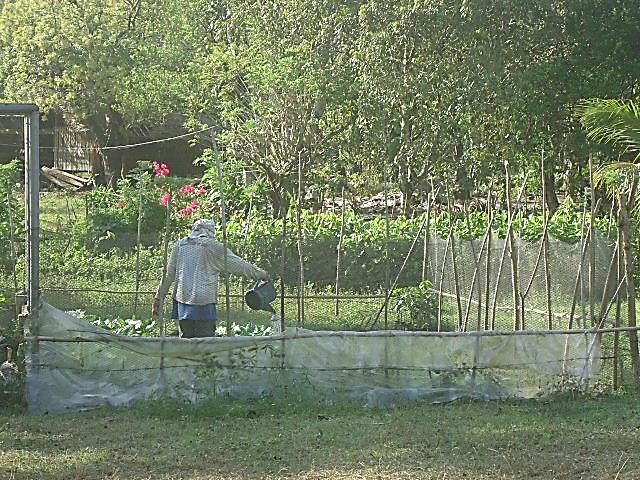
Plant Nursery Organic Vegetable Garden
The IRDF Techno-demo farm also promotes the conservation of traditional rice varieties and encourages community seedbanking to complement the promotion of organic farming practices. Genetic diversity is promoted to ensure that farmers would have a wide genetic pool upon which to improve their seeds. Through IRDF’s support, organic agriculture practitioners have been regularly sharing their experiences in seed conservation, improvement and breeding.
The following are the farmer partners in the techno-demo farm who are engaged in organic farming and seed improvement:
|
NAME |
BARANGAY |
LOCATION/ FARM SIZE |
RICE VARIETY |
DATE PLANTED |
|
TABON- TABON |
STO.DOMINGO – |
IR – 222 |
7-5-13 |
|
KALIAN |
KALIAN |
IRRI – M74 |
7-8-13 |
|
KALAAY |
KALAAY |
IR- 222 |
6-30-13 |
|
SAN PEDRO |
SAN PEDRO – |
HASMIN VIRNAL IC I60 |
7-21-13 |
|
BUENAVISTA |
BUENAVISTA – |
LACCASTA LLANINA RED RICE |
7-45-13 |
|
|
TABON- TABON |
STO.DOMINGO BOLALA. |
RC 18 |
7-8-13 |
|
BOLOS |
BOLOS |
IR- 222 |
8-15-13 |
|
BOLOS |
BOLOS |
IR – 222 |
8-15-13 |
4. COCO FIBER TWINING IN BGY. COGON, IROSIN, SORSOGON
Coconut farming communities in Sosogon are making use of fiber from the coconut husk, which otherwise are being thrown away as farm waste. Coco coir production is fastly becoming an economically important activity in the province of Sorsogon.
In Bgy.Cogon, the members of the women group GABAY are engaged in coco coir twining which produces coco bind (“lubid”) gives them an added source of income. Besides making coco bind, they also make coco fiber nets, made of coco bind which provide good soil erosion control.
Most of the women members of GABAY are coconut farmers. Together with their husband, they tend to small coconut farms which harvest coconuts every 45 days. About 1000 coconuts would yield 10 kgs of coconut coir. The women sell their coconut husks to a cooperative which process them into fiber and supplied back to the women to be woven into coco bind. The cooperative then buys back the coco bind at P2.50/ 15 meters.
About 12-15 women are engaged in coco twining daily. They can produce 500 pieces of coco bind (lubid) daily fetching a price of P1,250. Each twiner would be able to earn at least P100 daily.
They can also make at least two pieces of coco nets a day, which fetch at P350.00 per net. Sometimes the cooperative or company gets the net, sometimes they deliver it.
According to Ms. Dometita, the leader of GABAY , they can get higher income if there’s a sure buyer. At most 40 women in the barangay benefit from coco twining and coco net making. Twenty young students are also getting some extra money when they help their parents in making coco binds.
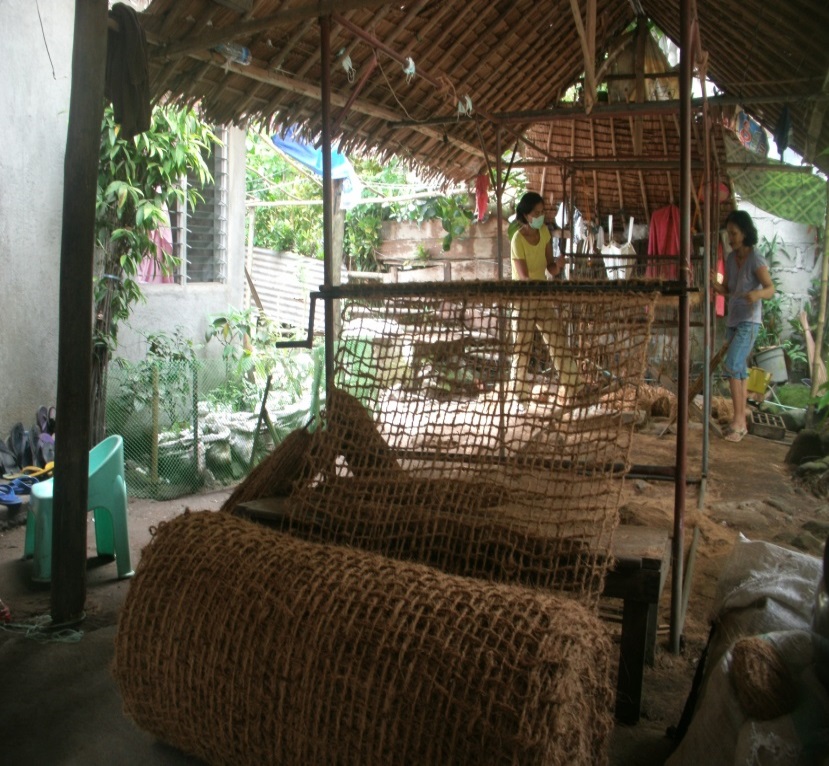
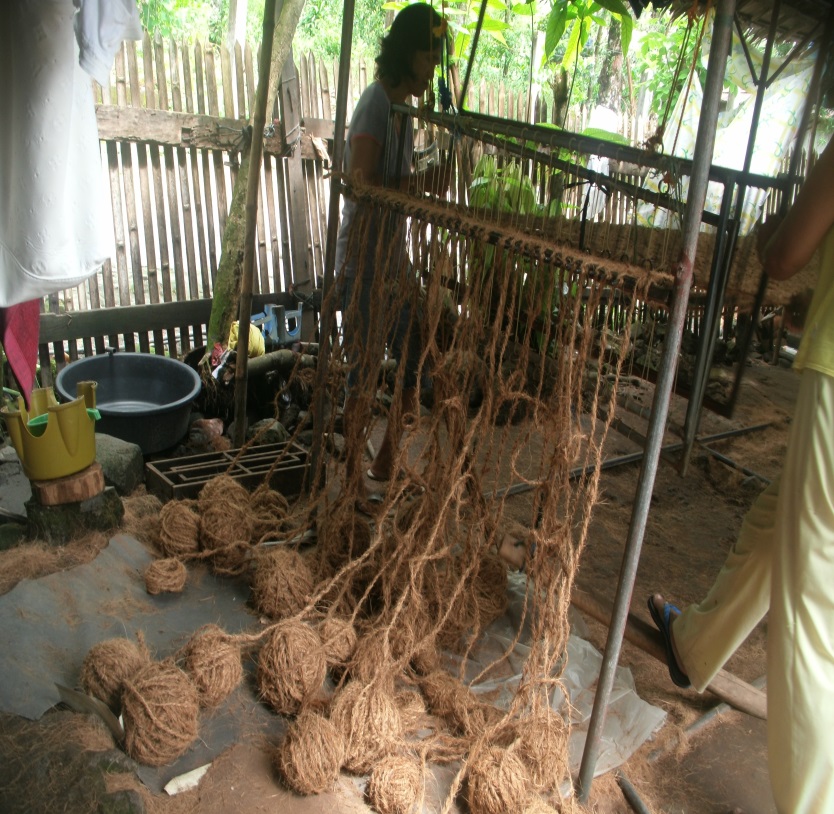
Figure 250 meters x 233 pieces
Coco twining in Bgy. Cogon evidently helps smallholders especially women earn additional income to meet their daily needs particularly food and the education of their children. As suggested by their leader, they can earn more income if they increase the volume of the fiber being processed as well as if they can integrate farm level processing with other higher level value-adding processing which can produce valuable products such as nets, mattresses, etc. They can also form a cooperative which can help them access more supplies of fiber and enable them to command a better price of coir products in the market.
